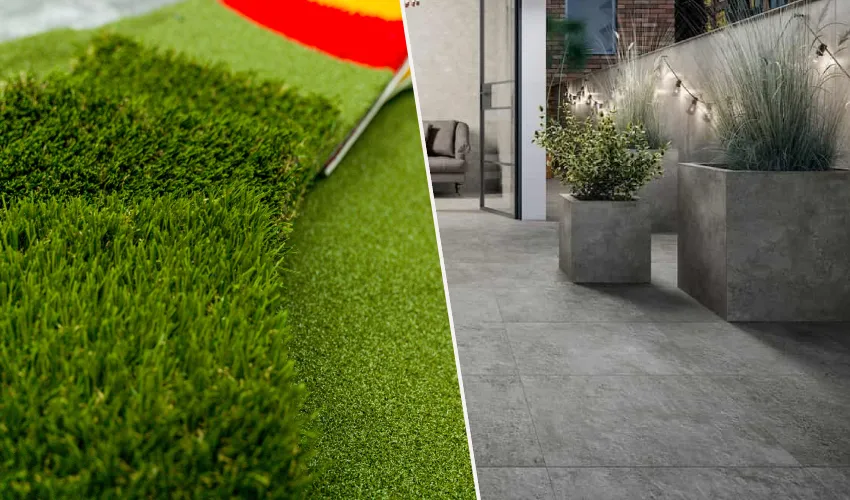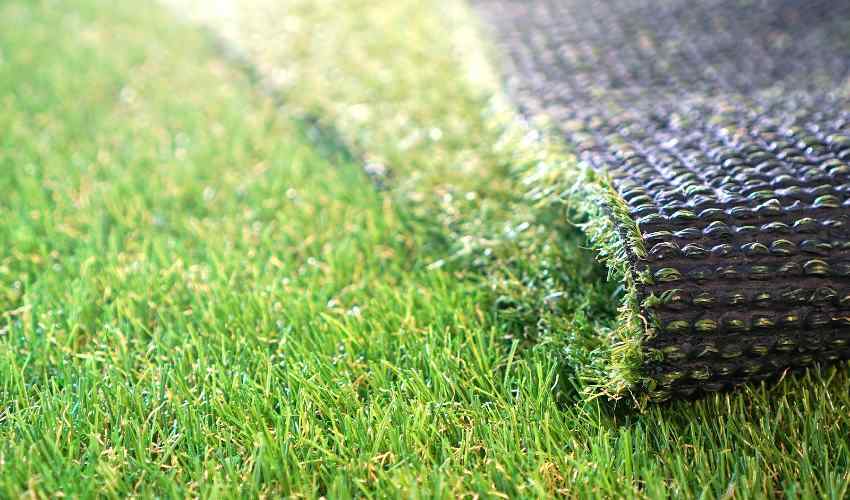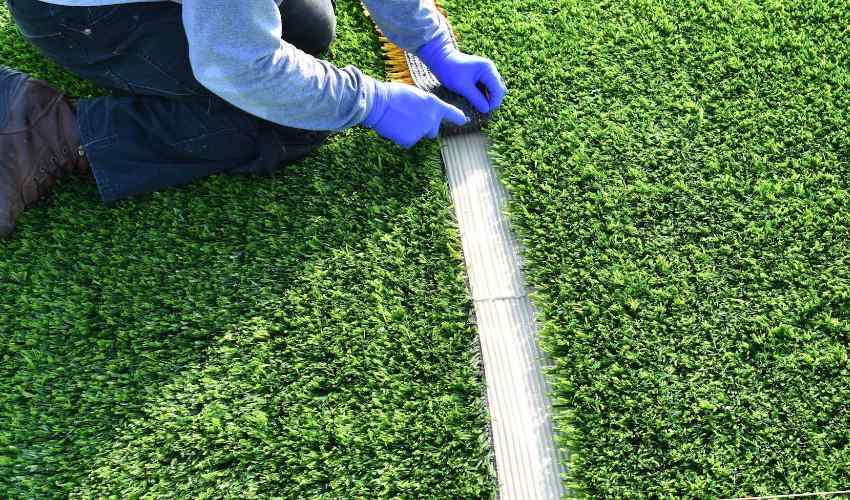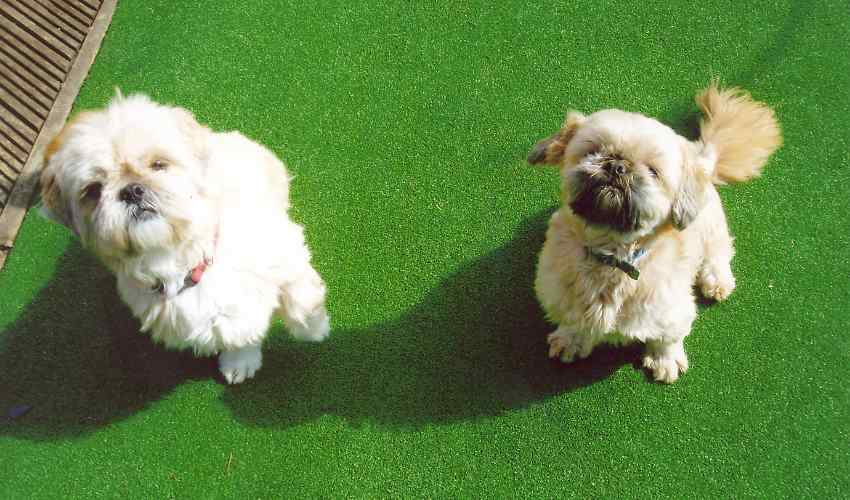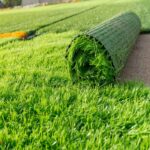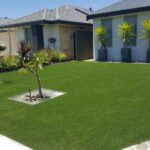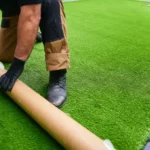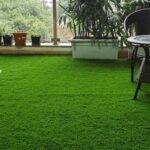For landscaping your backyard or garden in a low-maintenance way, artificial turf, and concrete are the two popular flooring treatments. Both synthetic turf and concrete are great options for renovating your outdoor spaces but the question that arises is which one is better?
The selection between these two options is not just about preferring looks and aesthetics, rather you have to determine a number of aspects such as what you want, the temperature conditions of your place, and the daily foot traffic it receives. This blog post by Fixitdesign examines the practical and ornamental features of each and provides a full analysis of their benefits and downsides.
Know The Similarities & Artificial Turf Vs Concrete To Choose The Best
Both these treatments have different construction, appearance, functionalities, and costs. So, it’s important to learn about them to make sure your hard-earned money is invested in worthwhile flooring.
What Is Artificial Grass?
Artificial turf is a highly practical alternative to natural grass and is manufactured using nylon, polyethylene, rubber, and other plastic materials. The blades of this grass are spun by machines and are backed by foam or rubber base materials.
Pros Of Artificial Grass
Fake turf comes with certain useful features that are given below:
Aesthetics And Comfort
Fake grass looks aesthetically pleasant and remains lively during all seasons. Its soft fibres with a rubber backing provide excellent cushioning and a comfortable surface to walk barefoot.
Low Maintenance
The major plus point of having synthetic turf is its low maintenance, meaning it doesn’t require frequent cleaning, unlike other flooring options. Also, this fake grass doesn’t need fertilizers, mowing, and watering, making it a convenient, cheap and hassle-free option for busy households.
Durability
Fake turf is the functionally favorable solution for every place because it features strong resistance against moisture, fading, wear and tear, and heat damage as well. It is the most durable option for high-traffic areas and you can expect this flooring treatment to last for more than 18 years with proper care.
Environment, Kid & Pet friendly
Another benefit of fake turf is that it doesn’t harm the environment because it doesn’t require huge amounts of water to grow. In addition to that, it doesn’t require harmful chemicals and doesn’t host insects that can cause health hazards. For homeowners with kids and pets, it’s an entirely safe and mess-free option.
Artificial Turf Is Versatile
Made from heavy-duty synthetic materials, artificial grass Dubai is a long-lasting addition to every commercial and residential space. You can not just install it in outdoor areas like balconies, patios, decks, terraces, backyards, and gardens but can also install it in indoor spaces such as hallways, corridors, and entrances for a welcoming feel. Also, it can be used in commercial spaces like libraries, retail stores, banquettes, hospitals, and healthcare facilities.
Cons Of Artificial Grass
Here are some of the disadvantages of synthetic turf.
Initial Installation Costs
The initial price of purchasing and installing artificial turf is higher than concrete floors. It’s definitely not the cheapest flooring treatment, however, the pricing is justified with their long-term serviceability and ease of maintenance, unlike other flooring options in the market.
Overheating In Summers
Fake grass is made from artificial fibres and can absorb heat during summer. You cannot walk barefoot over this grass on extremely sunny days. However, you can cool down this grass by spraying cold water.
Environmental Impact
Since artificial grass is made from plastic materials, it is non-biodegradable and ends up in landfills. Therefore, it is harmful to the environment.
Also Visit: Benefits of Natural Grass VS Artificial Grass
What Is Concrete Flooring?
Concrete is the sturdiest and most durable floor treatment that is manufactured using materials like cement, water, and aggregates including gravel, rock, and sand. With a hard-wearing surface, this flooring is widely used in many commercial and industrial settings.
Pros Of Concrete Floors
Here’s the list of all beneficial features that this floor treatment offers:
Appearance
Concrete floors give a sleek and smooth finish like a polished stone that looks inviting. However, even though these floors are customizable, they can appear dull as compared to green and lively grass. Outdoor areas need to be comfortable but concrete flooring can still be useful as it offers smooth, resilient, and robust surfaces which are great for a variety of outdoor activities like barbeque and bonfires.
Low Maintenance
Like artificial turf, concrete also requires little to no maintenance. A straightforward sweeping and mopping is enough to keep grime or dirt from building up. Also, this flooring doesn’t allow the growth of weed or mold so, you don’t need to clean and maintain it often.
Durability
When it comes to choosing the ideal floor covering for your area based on durability comparisons, concrete is the best option. Made from highly robust materials, concrete floors can endure intense foot traffic at home and impact of of heavy industrial machinery as well. If properly installed and cared for, it can last for more than 30 years.
Environmentally Friendly
Concrete floors are considered environment-friendly because their construction involves the usage of recycled materials. The materials include crushed glass, metal shavings, and marble chips can be recycled again once you remove the flooring. These recyclable materials can also be utilized in other flooring projects.
Functional Treatment
Concrete floors are the most practical addition to any space because of their excellent performance and durability. Polished concrete provides you with the advantage of light reflection and temperature regulation that contributes to the energy efficiency of the building. These floors also offer insulation and help you save on energy bills in winter. Additionally, they make anti-slip surfaces because they are treated with a sealant.
Cons Of Concrete Floors
Along with pros, concrete floors have certain disadvantages that are described below:
Hardness
Concrete floors can be uncomfortable to walk over barefoot. This is not a safe choice because a sudden slip or fall can cause serious injuries or physical harm.
Staining
Using cheaper concrete will require you the hassle of staining your floors that look unappealing. Moreover, to prevent tire markings on these floors, you need to avoid paint or oil spills over these floors. Even if you remove them, they can leave stains for a long time that can affect the appearance of the floors.
Difficult To Repair
Harsh use and improper installation can crack concrete floors over time; they need to be professionally treated to not make them more difficult to deal with. It’s time-consuming, arduous, and expensive to repair those cracks and breaks because you have to eliminate the entire flooring to fix the affected area.
Final Thoughts!
For outdoor landscaping, artificial grass and concrete flooring are the two most popular choices. Both of these flooring options come with some similarities and differences and it’s important to know their pros and cons to decide which one is better for your residential or commercial renovations.
To avoid hectic maintenance and have sustainable, allergen-free, and comfortable surfaces, artificial turf is the best choice to settle for. On the other hand, concrete is the ideal choice for areas with intense foot traffic and it also lasts longer than synthetic turf. We hope that the detailed pros and cons of each flooring treatment mentioned above will help you decide on a suitable option for your space.

